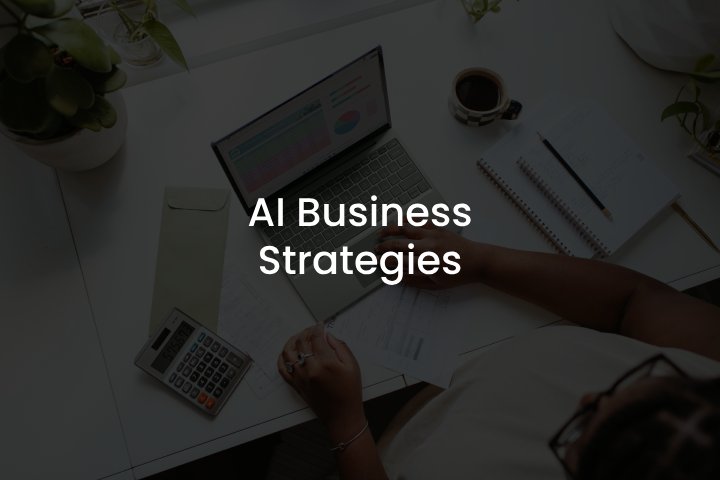
AI Business Strategies: Get a Competitive Advantage in the Digital Market
Organizations of all types and sizes are increasingly adopting AI in digital marketing automation, foreseeing market demands and customer needs, streamlining routine tasks, and developing data-based insights. With wise strategic planning and real-time risk mitigation, utilizing AI can play a pivotal role in shaping future markets and ensuring sustained growth.
How AI Is Used in Business in 2024?
Initially emerging in the software development sector (GitHub Copilot), AI quickly expanded to a broader market by enabling the instant creation of text and images (ChatGPT and Dall-E 2). By 2023, tech giants like Alphabet, Amazon, and Microsoft had capitalized on the technology, showcasing substantial stock index growth (around 80%). However, in 2024, the trend changed, with non-tech companies applying AI for process automation and boosting outputs. Smaller businesses will become the majority of early adopters, while larger ones involved in healthcare and financial service providers should reorganize their data governance to ensure safe AI implementation.
After a year of intensive testing, companies transition to widespread implementation of automatically generated content to gain more market advantages. AI product releases in the digital space are also exploding (e.g., Google’s Word and Excel extensions, including chatbots), while investments in generative Artificial Intelligence increased twice in 2023, reaching $36 billion.
The demand for AI talents will also remain high in 2024, with many companies increasing related job vacancies. Around 5% of advertisements now mention this technology, compared to 2.5% over the last three years.
Putting AI to work: uses and abuses
AI impacts business processes, boosting efficiency and facilitating rapid scaling. Key applications of leveraging AI across various sectors include:
- Increasing productivity. AI tools automate day-to-day tasks, reducing the dependence on human resources.
- Generating insights. Artificial Intelligence analyzes vast datasets to identify tendencies and familiar algorithms, helping make well-informed tactical decisions.
- Robust cybersecurity. AI applications allow companies to detect and prevent cyber threats in real time.
- Enhancing user experience. AI-driven personalization improves customer interactions and satisfaction.
Along with the apparent advantages of generative AI, it also drives several risks that organizations should timely address to ensure reliable outcomes:
- 1. Misuse. This includes malicious exploitation of AI capabilities, leading to scams, phishing, and cyberattacks. Preventive measures involve setting strict and transparent AI principles compatible with an organization’s ethical values and watermarking generated content.
- 2. Misapply, or “hallucination,” occurs when Artificial Intelligence generates inaccurate outputs that can harm individuals or companies. To mitigate the risk, it is common to build controlled AI environments, ensuring stringent privacy protection and tailored training to prevent reliance on misleading outputs.
- 3. Misrepresent. It entails intentionally spreading deceptive AI-generated content. Firms can address this issue by verifying results with labeling systems and cross-checking tools.
- 4. Misadventure refers to the accidental uptake and propagation of inauthentic AI-generated content. Deepfake mitigation involves awareness training for the whole company, integrating reliable validation systems, and developing damage prevention plans.
How businesses are using generative AI
Organizations are increasingly integrating genAI, such as GPT-4, to upgrade their efficiency across various sectors. Tech giants like Nvidia, Amazon, and Microsoft heavily invest in AI projects like customer support optimization or product development.
Also, AI is streamlining operations in the financial sector and retail. Mostly, companies use Artificial Inteligence to manage users’ queries, detect online crime, and create social media content.
For instance, JPMorgan Chase bank implemented over 300 AI use cases. At the same time, Bayer, an international pharmaceutical company, leverages more than 700 AI tools, including those for data extraction and document drafting. L’Oréal, the world’s largest cosmetics corporation, deploys AI to create unique advertisements and promotional campaigns. Sprinklr, a telecommunication giant, uses generative AI to optimize customer care, reducing call handling times and improving clients’ experience.
Despite some challenges concerning AI’s reliability, businesses are optimistic about the technology’s beneficial role in enhancing competence and user experience as they continue to implement AI tools into everyday workflows.
The bottom line: enabling business transformation with AI
To facilitate innovations with AI in 2024, organizations should consider the following points:
- Align AI investments with corporate goals for maximum productivity and new profit sources.
- Integrate AI across all functions to streamline tasks, simplify planning, and grow productivity.
- Build trusted AI governance patterns to ensure ethical use and mitigate risks.
- Train employees for AI adoption, stimulate human-AI collaboration, and prepare them for evolving roles.
By utilizing these strategies, businesses can fully uncover AI’s potential, boost innovation, improve performance, and gain leading market positions in 2024 and beyond.


